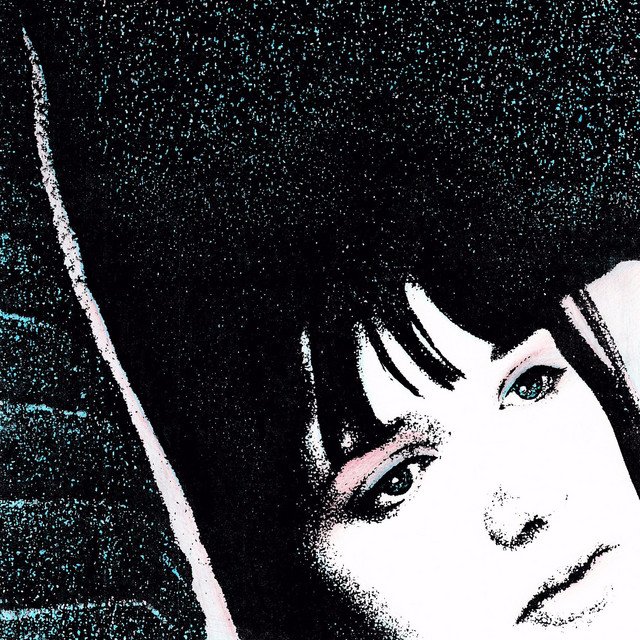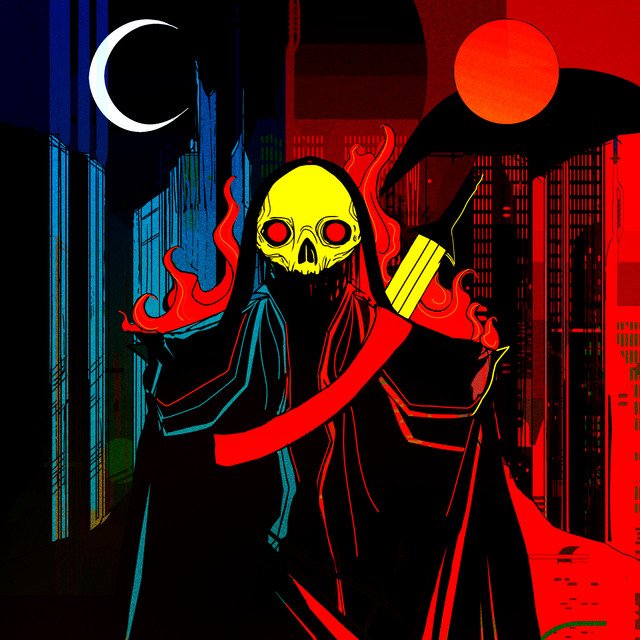Under your spell: diving into the catalog of Italians Do It Better.
A sampler of ten great albums from the legendary synth-pop label, Italians Do It Better.
Picture this: it’s midnight, and you’re cruising the darkened streets of L.A. in your Testarossa. You’re dressed to kill in your slickest bomber jacket and early-2000s skinny jeans. You’re wearing sunglasses even though it’s dark outside because you’re just that badass. You tear down the highway into the downtown area, and you’re bathed in the glow of the neon signs. You pull up to the club, drifting up to the curb. When you get out of the car, the bouncer recognizes you immediately and ushers you in—you’re a VIP. As you walk inside, you can feel the eyes of the onlookers burning holes in you. They want you. They want to be you. Of course, what they don’t know is that your immaculately curated aura of cool is just a facade; you wouldn’t be showing up alone at the club if it wasn’t. Your life isn’t a perfect fantasy. Like all lone wolves, you carry your demons with you like a set of car keys, but does that matter? No! Because in 2006, in Portland, Oregon, Johnny Jewel and Mike Simonetti founded a record label designed to make music for people like you—Italians Do It Better—and you know what? It ruled. And now, almost two decades later, Italians Do It Better is still operating, pumping out gloriously damaged synth-and-electropop records to soundtrack an entire generation of beautiful losers crying in the club, losing themselves to a haze of substances and disco beats. Taking their name from a t-shirt worn in Madonna’s “Papa Don’t Preach” music video and drawing heavily from the sonics ‘80s synthpop and italo disco, Italians Do It Better has specialized in supplying the world with what James Murphy might call “borrowed nostalgia for the unremembered ‘80s.” With their Tumblr-fied aesthetics, love for the cinematic, and their tendency to make everything sound like the score to a neon-noir film, the Italians Do It Better roster has cemented themselves as some of the current era’s most reliable sources of quality pop. Here are some of their best offerings.
Chromatics - Night Drive
Johnny Jewel and Ruth Radelet took a small, shitty Portland noise-rock band and turned them into an italo-disco powerhouse. By now, of course, there’s a whole slew of mythology around Chromatics and their label. But before Dear Tommy, and financial conflicts, and the endless Madonna covers, and even before “Tick of the Clock” soundtracked Ryan Gosling’s most badass moment on film, there was Night Drive.
In theory, Night Drive is an album meant for—well, it’s there in the name—driving at night. But, in practice, it’s much weirder. Sure, there are your cruising-down-Sunset-Boulevard classics (see: the title track, the delicate italo-house of “I Want Your Love’), but there’s also the Giallo-ready keyboard arpeggios of “Killing Spree” and the psychedelic ambiance of “Let’s Make This a Moment to Remember.” It’s about the beauty and menace of the city at night. There’s a reason why Nicolas Winding Refn wanted Jewel to soundtrack Drive —his neon-lit “arthouse action” thriller. Jewel and the gang know that 2:00 a.m. can be a magical time, but they also know that it’s a dark world out there, and it only gets darker at night. By the time Night Drive starts to close out, you’ve been exposed to the plaintive, pleading balladry of “Tomorrow Is So Far Away” and the smeary, racing-game electronica of “Accelerator.” What started as a drive home from the club has become something much stranger, and maybe much more magical.
Glass Candy - B/E/A/T/B/O/X
When you think of the ‘80s revival, you probably think of something much peppier than the trademark sunglasses-at-night moodiness that comes with Italians Do It Better: big hair, goofy dances, neon-lit bars where “Dancing With Myself” plays 24/7 on the stereos. Well, if that’s what you’re looking for, fear not! Johnny Jewel and Ida No have you covered. Like Ferris Bueller doing the Twist on the Macy’s parade float, B/E/A/T/B/O/X is effortlessly goofy and radiates charisma. This is an album that begins with a Jane Fonda workout tape parody. It has a (great) song called “Candy Castle” and a note-for-note cover of Kraftwerk’s “Computer Love.” Don’t take this one seriously, just roll with it.
It helps that B/E/A/T/B/O/X shamelessly embraces its cheesiest ‘80s influences, from glossy, big-budget funk to club-ready synthpop. If Chromatics are the equivalent of Phil Collins giving a thousand-yard stare, ready to pound the shit out of his drums, Glass Candy is like Prince squealing while straddling a motorcycle. From the almost Hi-NRG throb of “Beatific” to the triumphant stabs of canned horn that punctuate the chorus of “Rolling Down the Hills,” B/E/A/T/B/O/X commits itself to camp. Even when it tries at seriousness, such as on the icy, Depeche Mode-aping electro of “Digital Versicolor,” you still get lyrics like “this is yellow, this is yellow, this is yellow” (repeat ad infinitum)—meaningless on paper, but perfect for screaming out on the dancefloor. At its core, B/E/A/T/B/O/X is a reminder that sometimes you have to let yourself go. So, get decked out in your best spandex, put on your gogo boots, and hit it, DJ!
Various Artists - After Dark
The third of the “big three” albums that announced Italians Do It Better to the world (and won them acclaim), After Dark might be, however strangely, the label’s most successful export from their early years (at least, it’s the only Italians Do It Better album I ever seem to find in record stores). Designed as a compilation of the then-nascent label’s early work, After Dark remains its de facto introduction: it might not get that deep into any one particular style, but it’s a nice sampler of what its roster could do, and it loads itself up with enough classics that you don’t notice the disjointedness.
There are a few songs that already show up on other albums, like “Computer Love” and the brief “Killing Spree (Suite 304 Demo),” near-identical to its final cut on Night Drive, but the album sounds fresh to this day. Glass Candy’s cover of Belle Epoque’s euro-disco hit “Miss Broadway” trades the original’s faux-reggae beat and plasticky sound for plinking, high-tension keys and a gloriously cinematic horn outro. Similarly, Farah’s “Dancing Girl (Suite 304 Demo)” has her sing in Farsi over a blocky, YMO-evoking oriental riff. It’s menacing and strange, but you can’t help but dance along. There’s a reason why a bunch of Portland punks were able to conquer the ‘80s revival, and it’s because of albums like this. There would be more After Dark albums, but none of them would approach the heights of the original. Not many albums can.
Desire - II
By 2009, Italians Do It Better had been a label for 3 years, and had a few now-classic releases under their belt, so it’s perhaps no surprise that their image began to codify right around then. Indeed, in checking out Desire’s debut, it’s easy to spot most of the tropes that would go on to define the label: the moody, romantic atmosphere, the nocturnal lushness, the French. Even the grainy, black-and-white cover, with its resemblance to Nico’s goth classic The Marble Index, suggests a kind of maudlin sophistication. In Megan Louise’s world, heartbreak is smothered in expensive champagne, clove cigarettes, and late-night confessions scrawled on dirty bathroom mirrors in pink lipstick.
From its opener, the brooding, minimalistic “Montre moi ton visage,” Desire showers you with a mournful melodrama that could have only existed in the Twilight era: "I ran into the starlight and never came home, because I haven’t got one.” The whole album alternates between Tumblr-worthy emo-isms and the kind of breathless romanticism that would make Carly Rae Jepsen a star some years later (see also: “do you think this feeling could last forever? you mean like forever ever?”). Barring a little bit of canned guitar that shows up at the beginning, II relies solely on a combination of synths and percussion to give itself a minimalistic iciness, bringing to mind the sleek sophisti-pop of the Blue Nile, or else the Outrun genre that would pop up a few years in its wake. “Colorless Sky” drowns itself in a shimmering dream-pop ambience, while “Don’t Call” rides out a cabaret-like pulse until it fades out. It’s a masterful display of popcraft, a little microcosm of heartbreak playing out into the night.
Symmetry - Themes for an Imaginary Film
In 2010, Nicolas Winding Refn hired Johnny Jewel to compose the music for Drive, only to later replace him with Cliff Martinez. Never one to waste a good already-written film score, Jewel teamed up with his Chromatics bandmate Nat Walker to put together Themes for an Imaginary Film, refining his original product into a two-hour long electronica opus, loaded with ominous synth hums and emotive John Williams-indebted strings. Themes isn’t entirely devoid of beats—the distorted, minor-key grind of “City of Dreams” sounds like it could underlay any number of Detroit street-rap classics, and “The Messenger” layers an trap pulse under its melancholic pianos and violins, although it mostly consists of shapeless synthwave soundscapes.
Jewel and Walker aren't shy about their influences—you could slot the exotica-esque “Cruise Control” in between any number of Vangelis songs on a playlist and no one would notice the difference—but for the most part, Themes’ hushed, mournful instrumentals sound masterfully like their usual fare with Chromatics. With its psychedelic vocalizations and menacing string motif, the brief-but-excellent “The Nightshift” serves as an excellent prelude for their more dark-ambient influenced later work. Similarly, the twinkling keys of “The Fading Faces” are almost a dead ringer for “Killing Spree.” When Ruth Radelet shows up on the ethereal, almost-a capella “Streets of Fire,” it’s like hearing an old friend. Ultimately, rather than a break from the usual Italians Do It Better fare, Themes for an Imaginary Film serves as an excellent expansion of its world.
Chromatics - Kill for Love
It feels like cheating to put two albums from the same group here, but if there’s any group where doing so seems fair, it’s Chromatics. First, they’re the label’s flagship band—without Chromatics, there’s no Italians Do It Better. Second, Kill for Love rules. It’s 77 minutes of cinematic, menacing back-alley synthwave. Critics have been describing neofolk and black metal albums as “post-apocalyptic” since forever, but Kill for Love is the only album I can think of that truly fits the description. It’s all negative space: from the guitars to the synths to the drums, the production is cloaked in some kind of emptiness.
If there’s one slight failing that can be attributed to Kill for Love, it’s that it can be a little same-y, and there is a point in the middle where things start to blur together (though even that’s broken up by the haunting, Eno-meets-Lynch synthscape “Broken Mirrors”), but that only accentuates the album’s finer moments! You can feel the tension in the reverbed-out Neil Young guitar line on “Into the Black,” and the giddy dance-pop riff of “At Your Door” sounds almost 3-D. And “There’s a Light Out on the Horizon” gives a quietly tragic conclusion to “The Telephone Call” from Night Drive, with Radelet’s phone call fading into a sea of melancholic synths and hair-trigger drum beats. If Night Drive is the comedown, Kill for Love is the morning after, laced with regret. Of course, once you’ve finished, you can’t wait to do it all again.
Ramxes - Deep Crimson
Okay, now we’re moving away from the label’s flagship artists into the B-team. That’s not meant to be disparaging—sometimes, the B-team is disappointing, but this most definitely isn’t one of those times. The proof? Ramxes’ avant-electronica masterpiece Deep Crimson, which sounds like if someone tried to turn Neil Stephenson’s Snow Crash into an album and went off the rails with it. There’s literally a song called “Bibliotech Virus.” And check that crazy grim-reaper-goes-Shadowrun cover. It doesn’t get much more futuristic than this.
Of course, a great concept without great music is nothing, but Ramxes delivers on all fronts. The aforementioned “Bibliotech Virus” is a great example of his talents. Blending a bouncy electro beat (that recalls Geometry Dash) with a single-note keyboard drone and a throbbing post-punk bassline, it plays like a car chase through a chromed-out neo-Tokyo. With its effortlessly catchy lo-fi hook and nocturnal production, “Neptune Drive” establishes itself as an all-time midnight driving song. Even the 41-second “As the World Turns” manages to make the most out of its short runtime, layering plaintive, reverb-drenched guitar lines over each other while building to the pulsing EDM-meets-R&B-meets-Gamelan of “Mobile Suit.” If the previous entries have doubled as somewhat of a historical primer, showing Italians Do It Better’s glorious heyday, Deep Crimson provides a glimpse into its future. Gorgeous, experimental, and downright crazy, it’s a testament to the limitless vision of its creator.
Joon - Dream Again
Joon formally introduced herself in 2020 with her two contributions to the label’s After Dark 3 compilation (if you haven’t done so already, check out her icy, dance-pop cover of Bananarama’s “Cruel Summer”). Dream Again distills her sound into its purest form: harsh, industrial synth tones, drilling percussion, and hushed, otherworldly ambience. In the Italians Do It Better catalog, this is perhaps the most “electronic” that they’ve ever gotten. While almost all the label’s releases have been clubby and danceable, Dream Again is their most rave-able album, with its almost EDM-like drumbeats and sharp, bubblegum hooks.
The album’s best moments are the ones that play up these traits. Take, for example, the aptly-named opening track, “E.T.” Sporting a loping, electronic bassline and a Rapture-worthy cowbell rhythm, it sounds like what an alien might play if it had to DJ a rave. Similarly, “Just Can’t Get Enough” sounds like a million bar mitzvah-ready pop smashes broken down to their purest form; Joon shouts out lovestruck gibberish over an almost garishly catchy synth hook, mixed to drown out everything else. Even the album’s more experimental moments are perfectly tailored for dancing: “Wait” fuses Witch House ambience with a twitchy synth melody that recalls Chromatics at their best, while “I.You” sounds like what might happened if you mashed up the most melodic elements of Kavkinsky’s discography. It’s proof of one of the label’s most defining philosophies: you can be as strange as you want to and still make bangers. Sometimes, in fact, the strangeness helps.
MOTHERMARY - I Am Your God
Sometimes you just need a good pop album. Well, Italians Do It Better has got you covered. With I Am Your God, MOTHERMARY gave the world one of 2022’s great pop statements. Formed by Larena and Elyse Winn after their departure from Mormonism, I Am Your God delivers crystalline electronica and ethereal wave with divinely-inspired gravitas. If you like Christine and the Queens, or Charli XCX, or Caroline Polachek, then you can add MOTHERMARY to your list.
It’s hard to say just what the best song on I Am Your God is. It could be the moody, Kacy Hill-esque R&B of “Wearing Me Thin,” with its murky synths and the Winn sisters’ stentorian, hushed vocals. On the other hand, “Give It Up” is pure dancefloor manna with its throbbing industrial beat and soaring, spacey chorus. Even their cover of “Like a Prayer” stands up to the original, updating the rapid-fire Hi-NRG of Madonna’s classic into clubby, EDM-inflected electropop. On the song’s title track, the Winn sisters give a succinct thesis to the album: “just wanna hear you say I am your god.” MOTHERMARY knows they’re better than you. And you know what? They’ve earned the right to feel that way. Try to listen to the glitched-out technopop of “Pray” without dancing.
Causeway - We Were Never Lost
As much as I love every artist on this list individually, the point of the article still stands: this is about the label. The whole thing is about drawing attention to Italians Do It Better, which is why it only makes sense to close out the list with the most Italians Do It Better-y album that any artist on the roster has released. That album being, of course, Causeway’s We Were Never Lost. Listen to opener “Let Me Love You,” with its almost minute-long intro of cinematic synths and its throbbing, italo house beat. If you had to sum up Italians Do It Better with one song, it would be that one.
Or maybe it would be the obligatory Madonna cover, “Crazy For You,” which trades the Roxy Music-style sophistication of the original for an almost-gothic heaviness. In Allison Rae’s hands, it goes from being flirty to deliriously needy, with a gloriously-timed beat drop turning a couplet like “I see you in the smoky air / can you feel the weight of my stare?” from a throwaway line into a Danielle Steele-esque declaration of desire. Rae does the opposite with her cover of New Order’s “Your Silent Face,” turning it from an uptempo ballad to rave-ready dance pop. “Birthday” closes out the album with a perfect blend of joy and regret. When Rae sings “I wish you were here,” you believe her, but it’s impossible not to smile at the transcendent, fist-pumping wash of synths that follows her lyrics.
And at the end of the day, that’s the whole point of Italians Do It Better. Yes, there’s darkness and heartbreak out there, but there’s also transcendent beauty. And, sometimes, you need to cry and get in your feelings, or you want to get out there and drive around all night to try and run away from your problems. There’s nothing wrong with that. We all need an escape sometimes. Here’s to many more years of them.
edited by Alondra Romero.
album artwork believed to belong to either the publisher of the work or the artist.











